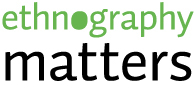The god in small things: Ethnomethodology takes ethnography to the details [Syllabus as Essay Series] [guest contributor]
Our June guest contributor is an inter-disciplinary ethnographer, Barry Brown, who is well known for his work in Human-Computer-Interaction, Sociology, and Communications. He pioneered the study of leisure and entertainment in social computing and has applied it to research on augmented reality video games, mixed-reality museum visiting, mobile collaborative tourism, and transportation. Barry recently joined Mobile Life at University of Stockholm as the center Co-Director.
We’ll do an interview with Barry in another post about his career as an ethnographer who has worked in many industrial and academic settings. For today, we asked Barry to talk to us about something that very few ethnographers talk about – ethnomethodology.
When I first heard of the word, I cringed because it just sounded boring and unsexy. It’s hard enough to explain to people what ethnography is. Luckily, Barry was the first person to not only introduce me to ethnomethodology, but mentor me in the techniques of and wonders of ethnomethodology.
So what’s the best best way we can do our first post on ethnomethodology at Ethnography Matters? A curated reading list!
We asked Barry to curate the first post in our Syllabus as Essay reading series. In this post, Barry explains how ethnomethodology helps us answer questions that sociological theories just can’t. He also suggests reading Mike Lynch, an author I blogged about a while back on Cultural Bytes. Barry covers Garfinkel and guides us through Harvey Sack’s writing by recommending specific chapters in his oeuvre. He then ends with the philosopher, Wittgenstein, who inspired thinkers across multiple disciplines.
If you would like to contribute to the Syllabus as Essay series, please reach out ethnography matters [at] gmail [dot] com.
Enjoy! Tricia and team.
I work with ethnography and the design of technology – a not uncommon role for contributors to this blog. It’s something of a truism to say that, when working with computer systems, the details matter. Not just in the case of a semi colon versus a full stop, your ‘p’s and ‘q’s all in the right place, but in the ways in which the right font here or a well designed feature can turn a computer system from useless to must have. This attention to detail – ‘sweating the small stuff’ is based on the assumption that what we see as ‘big things’ naturally and unavoidably rest upon the small.
 For that reason I’ve always thought there’s something of a natural affinity between computer science – or the design of technology more broadly – and my particular favourite flavour of ethnography. “Ethnomethodology” is a particularly odd branch of sociology, obsessed to a quite unhealthily degree with ‘the details’ of social life and social interaction. It is an ‘-ology’ that looks at the methods whereby people live their lives – how we interact (Sacks 1995), talk (Atkinson and Heritage 1984), walk (Ryave and Schenkein 1974), work (Button 1993), travel (McHugh, et al. 1974), break the law (Sacks 1972) or cry (Beach and LeBaron 2002). So, for example, when we converse we do not usually all talk at once – there is structure in our turn taking activity (Sacks, et al. 1974). When we offer an invitation there are certain ways of refusing that avoid rudeness (Sacks 1995).
For that reason I’ve always thought there’s something of a natural affinity between computer science – or the design of technology more broadly – and my particular favourite flavour of ethnography. “Ethnomethodology” is a particularly odd branch of sociology, obsessed to a quite unhealthily degree with ‘the details’ of social life and social interaction. It is an ‘-ology’ that looks at the methods whereby people live their lives – how we interact (Sacks 1995), talk (Atkinson and Heritage 1984), walk (Ryave and Schenkein 1974), work (Button 1993), travel (McHugh, et al. 1974), break the law (Sacks 1972) or cry (Beach and LeBaron 2002). So, for example, when we converse we do not usually all talk at once – there is structure in our turn taking activity (Sacks, et al. 1974). When we offer an invitation there are certain ways of refusing that avoid rudeness (Sacks 1995).
Our activities are structured yet not simply determined by these structures. Rather structures are seen and used in the everyday organization of this activity. These are the structures that ethnomethodology has studied – something of an inversion of the notion of ‘structure’ as it is commonly deployed in the social sciences (Garfinkel 2002). Read More…






Recent Comments